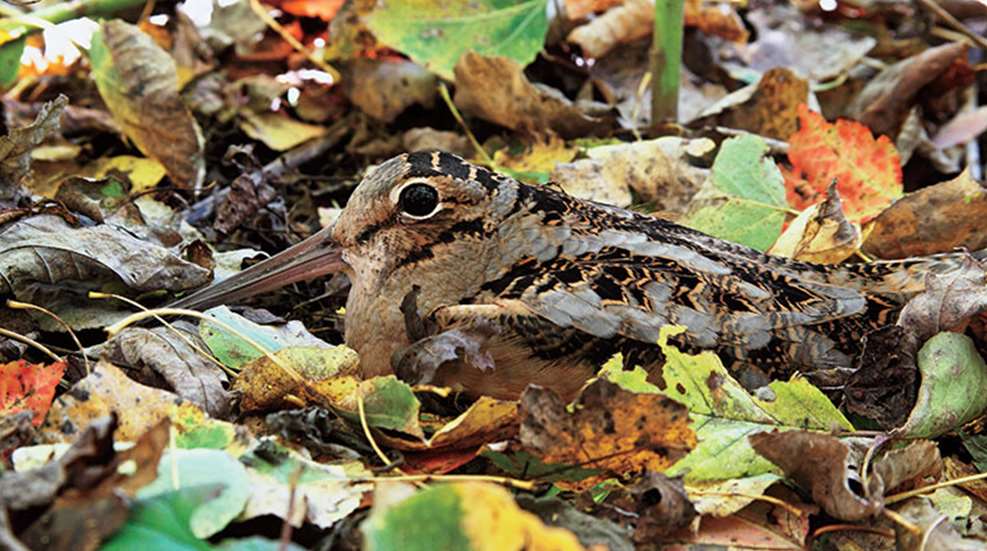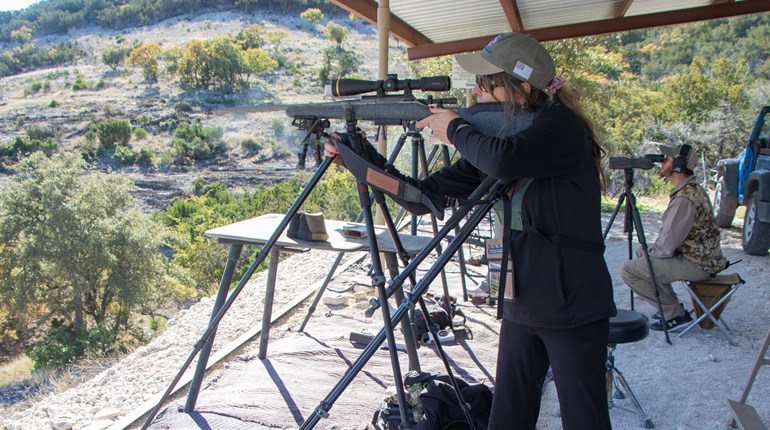
He’s called the “Labrador Twister,” yet his flight speed never exceeds 5 mph. His peeps call him “Timberdoodle,” his ex-girlfriend a dumpy, bog-sucking mudsnipe. But he can bust a move with his springtime “sky dance.” Surely you know him. He’s the one who rattles your nerves, crouching motionlessly on the ground until you almost step on him before he explodes at your feet. His bill seems long for his body, his eyes far back in his head, but that lets him spy your gundog’s approach while digging for worms. He’s a bird, but he’s no birdbrain—partly because, as bird brains go, his is upside down.
This dweller of the forest floor is the world’s slowest-flying bird: the American woodcock, the migratory gamebird known in the country’s northern regions as the harbinger of spring because of the male’s unique courtship flight. Though classified with shorebirds, it prefers upland settings in the eastern half of North America and is the continent’s only woodcock species and one of five worldwide.
Woodcock thrive in young forests where its brown, black and gray plumage provides excellent camouflage. Its ears and eyes are so large the cerebellum, which controls coordination and balance, sits below the rest of its brain instead of in the rear of the skull like other birds. This seemingly out-of-place shorebird evolved into quite the effective ground-prober. Its eyes moved back, the bill lengthened and the nostrils approached the base of its forceps-like bill so it could dig for its favorite meal: the earthworm. It drums the ground with its feet while rocking back and forth so worms move to the surface. This feeding habit forces it to migrate as soon as the ground starts to freeze, moving alone or in flocks called “flights” and resting or feeding in thickets by day. When a crafty hunter flushes ol’ Woody, he’s greeted by whistling wings and a hasty retreat that challenges even the most instinctive shotgunners.

In spring, males establish singing grounds where they perform a twilight mating dance. They make an insect-like “peent” that sounds like the call of a nighthawk, which continues over several minutes in 30-second intervals. Then the bird spirals upward on twittering wings, reaching heights of 300 feet before descending in a zigzag pattern while chirping. It dive-bombs the last 20 feet, hits the ground and struts. The ritual repeats until one or more females respond and the birds mate.
Considering “sky dances” can last from dusk to dawn, the next time your hunting buddy says he witnessed the floorshow or mentions “the Labrador twister clocked in with an all-time record flight speed of 5 mph,” you’ll know that’s no joke—as timberdoodle tornadoes go. But don’t think the slower they are the easier they are to hit. If that were the case, hunters would have a much easier time bagging their fair share.
Tracking Timberdoodle
A female woodcock raises only one brood of three to four chicks a year. While chicks have a 60 to 75 percent success rate, the population has fallen by more than 1 percent annually since the 1960s due to urban development and forest maturation. Birds that migrate north too early are also caught in late-season snows and freezing cold, which seal off their food supply.
The U.S. Fish and Wildlife Service (USFWS) lists the American woodcock as a “gamebird below desired condition.” In 2001, the Association of Fish and Wildlife Agencies and like-minded organizations formed the Woodcock Task Force. In 2007 the force published the American Woodcock Conservation Plan documenting a decrease of 839,000 singing male woodcocks across their range since the 1970s. Initiatives have been implemented in the United States and Canada to halt population decline and achieve growth by 2022. For details, visit timberdoodle.org.
Woodcock Range
There are two major American woodcock populations in North America, each inhabiting a separate region: the eastern region from the Appalachian Mountains east and the central region from west of the Appalachians to the Great Plains. Woodcocks live in the North in early spring and summer then migrate to wintering grounds in the southern and Gulf Coast states using three main flyways: the Atlantic Seaboard, west of the Appalachians and the Mississippi Valley. They breed across eastern North America from southern Canada to the Great Lakes region and as far south as West Virginia.
Hunters pursue woodcock in nearly 40 states and five Canadian provinces. New Brunswick rivals Louisiana as a famous haven for woodcock in addition to Wisconsin, Michigan, New York and New Jersey.
Did You Know?
• Migrating at an altitude of 50 feet, the woodcock collides with large buildings in higher percentages than other birds.
• Cocker spaniels were originally bred for hunting the Eurasian woodcock in the United Kingdom, hence the name “cocker.”
• Chicago Wilderness magazine invites readers wishing to observe the woodcock mating dance to attend one of the “woodcock walks” scheduled in breeding areas in Illinois each spring.
• Often mistaken for the woodcock, the common snipe has such an erratic flight pattern that hunters often misjudge lead, giving rise to the term “sniper,” referring to a skilled military sharpshooter.
• Woodcocks may fly 2 miles in one evening looking for food.
• Hunters recognize a group of woodcocks by many collective names, including a “fall,” “cord,” “rush,” “plump” and “flight.”




































